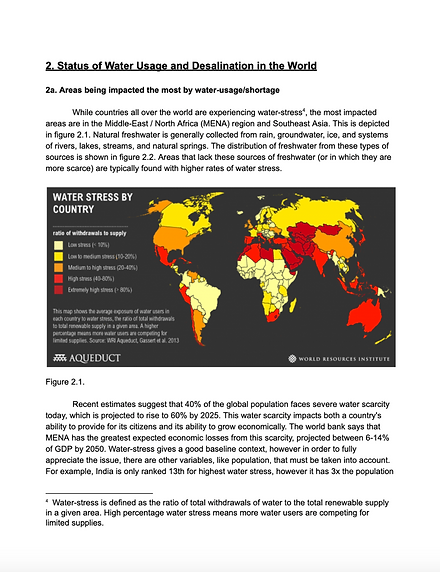
Flint's Engineering Portfolio
Desalination
Angel Investor
Contracted by an Angel Investor because of my lab and microfluidics experience to research desalination technologies and to attempt to innovate in the field. I came up with a novel idea that I was funded to attempt to build. I was unable to prove my concept and the project stopped.
Literature and history review of desalination [https://docs.google.com/document/d/1BHwGpK9rZO1hv2d3NLuGseqbbI7ohTYcVIpQsEpGnaI/edit?usp=sharing]





Idea
My hypothesis was as follows:
—————————————————————————— ——————— Impermeable wall
→Feed solution (salt water)
→Brine waste product
H20↓ leaves because of osmotic pressure
—————————————————————————— ——————— 1st Osmosis membrane
H20↓ gain of pressure
→Draw solution (concentration of something that overcomes the osmotic pressure of the feed solution)
→Recirculate Draw Solution
H20↓ leaves in order to re-establish equilibrium pressure
—————————————————————————— ——————— 2nd Osmosis membrane
H20↓
Collection chamber (not sure yet what this will be, maybe air, maybe a weak vacuum?)
→→→→→→Desalinated Water Product
—————————————————————————— ——————— Impermeable wall
The osmotic pressure of a feed solution consisting of pre-treated salt water (pre-treated to take out large substances, the same as is done in all other desalination technologies to prevent membrane fouling and scale build-up) will be overcome by a draw solution containing a high concentration of another substance. This pressure imbalance will pull water molecules across the 1st osmosis membrane into the draw solution chamber. The draw solution chamber will be a closed system in the sense that the draw solution will be constantly recirculated within the same, fixed volume (though of course it has semi-permeable walls in-between it and the other chambers for the movement of water). Since the membranes have a certain amount of flex, when water rushes into the draw solution chamber, it will increase the volume until a critical pressure*, when the membrane has swelled up and will not flex anymore (meaning it will not pull any more water into it). This can be visualized by the classic experiment of a cell in a hypotonic environment, where water rushes into the cytoplasm, eventually bursting the cell wall. This is, effectively, the starting point for the desalination process. Now, because the draw solution substance is still at a much higher concentration than the feed water concentration, the draw solution chamber is still overcoming the osmotic pressure, and therefore will continue to try and pull water into it. From this timepoint on, the disequilibrium created by each water molecule being pulled into the draw solution will push another water molecule across the 2nd osmosis membrane into the collection chamber, which will be at a lower pressure than the draw solution chamber. The force exerted on a molecule to enter the collection chamber must be higher than the force exerted on a water molecule to go backwards, re-entering the feed solution. This might be done by keeping the collection chamber cold and at a low pressure, maybe via a heat sink and/or weak vacuum. When water passes through the 2nd osmosis membrane into the collection chamber, it will be removed from the system as desalinated water product!
*The aim would be for the water to be pulled out of the draw solution chamber into the collection chamber long before the critical pressure to burst the membrane. This seemed like the best way to express the thought however.
More concisely:
The osmotic pressure imbalance will push water across the first osmosis membrane.
The pressure imbalance created by water entering the fixed volume of the draw solution chamber will push water across the second osmosis membrane.
Pressure relationships (id = into draw chamber; if = into feed chamber; ic - into collection chamber:
P(id) > P(if)
P(ic) > P(id) && P(ic) > P(if)
We will have to make sure the membranes can withstand the swelling/flexing that will inevitably occur during the change in volume from the intake of water from the salt solution. One idea here is using a reverse osmosis membrane instead of a forward osmosis membrane because for RO they use very rigid polymer backbones that make the membrane can withstand the high hydraulic forces applied.
First experimental flow cell:


Second experimental flowcell:



Working prototype printed flow cell holder:
Includes M/F Luer-Lock adapters for interchangeable solution pipetting and locking. It is printed in a transparent plastic in order to troubleshoot bubbles in the flow cell. I built the CAD for this in Fusion360 with a friend of mine who is more advanced than I who helped speed up the process.






